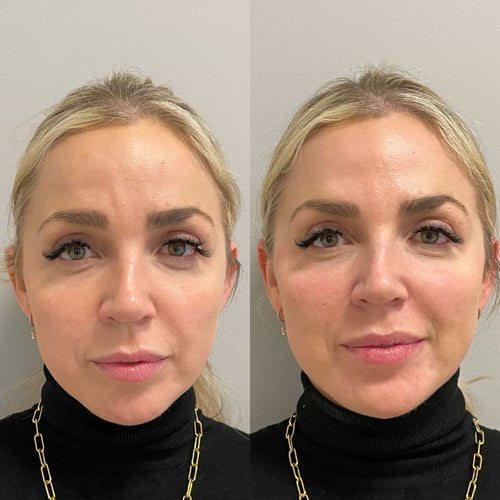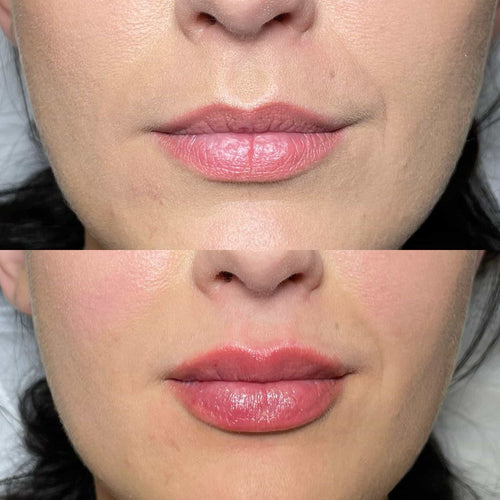Book Your Dermal Filler Appointment with Dr. Laura Geige Today

Numbing Preparations
Topical Anesthetics
Numbing preparations and topical anesthetics play a crucial role in minimizing discomfort during lip filler injections.
They work by temporarily blocking nerve signals, preventing pain sensation from being transmitted to the brain.
Here’s a closer look at common numbing preparations used for lip fillers:
-
Lidocaine: A local anesthetic often mixed with hyaluronic acid filler products. Its rapid onset and short duration make it ideal for minimizing injection pain.
-
Prilocaine: Similar to lidocaine, prilocaine is also a commonly used topical anesthetic known for its effectiveness in reducing discomfort during procedures like lip fillers.
-
Benzocaine: Another widely used topical anesthetic that comes in various forms, such as creams and gels. It can effectively numb the skin before injection.
Applying numbing preparations typically involves:
-
Cleansing the lip area with soap and water to remove dirt and oils.
-
Gently drying the skin.
-
Applying a thin layer of numbing cream or gel to the lips. Allow it to sit for the recommended time, usually 15-30 minutes, before the injection.
It’s important to note that individual responses to numbing agents may vary.
Always follow your provider’s instructions regarding numbing preparations and duration of application.
They can recommend the most suitable option for your specific needs and ensure a comfortable experience during your lip filler treatment.
Ice Packs
Numbing preparations are crucial for minimizing discomfort during lip filler procedures.
Topical anesthetics, such as lidocaine or benzocaine creams, can be applied to the lips 30-60 minutes prior to treatment. These creams create a barrier that temporarily blocks nerve impulses responsible for pain signals.
Ice packs are another effective method of reducing lip filler pain. Applying an ice pack wrapped in a towel to the lips for 15-20 minutes before the procedure can help numb the area and reduce inflammation.
The cold temperature constricts blood vessels, minimizing swelling and sensitivity.
Combining numbing preparations with proper injection techniques by a skilled practitioner is the best way to ensure a comfortable experience during lip filler treatment.
Over-the-Counter Pain Relievers
Numbing preparations are crucial for minimizing discomfort during lip filler procedures. Topical anesthetics, applied to the lips prior to injection, create a temporary barrier that blocks pain signals from reaching the nerves.
Benzocaine and lidocaine are common active ingredients found in these numbing creams or gels. They typically take effect within 15-20 minutes and can last for around one to two hours, providing adequate relief during the procedure.
It’s essential to follow the manufacturer’s instructions carefully when using topical anesthetics. Some products may require pre-application testing to ensure no adverse reactions occur.
In addition to topical numbing, over-the-counter pain relievers can further reduce post-injection discomfort. Ibuprofen and acetaminophen are readily available options that effectively manage mild to moderate pain.
These medications work by reducing inflammation and blocking pain signals in the brain. It’s advisable to take them as directed on the packaging or consult with a healthcare professional for appropriate dosage based on your individual needs.
Remember, numbing preparations and over-the-counter pain relievers are not substitutes for professional medical advice. Always consult with a qualified practitioner before undergoing any cosmetic procedure or taking medications, especially if you have pre-existing medical conditions or allergies.
During the Procedure
Communication is Key
During any cosmetic procedure, effective communication between the patient and practitioner is paramount for a positive experience and optimal results.

When it comes to lip filler injections, clear and open communication can significantly reduce anxiety and discomfort.
-
Before the Procedure:
-
Discuss your desired outcome:
-
Be specific about the shape, size, and fullness you envision for your lips.
-
Show the practitioner photos of your inspiration or desired look.
-
Clarify the type of filler being used:
-
Ask about the ingredients, expected duration of results, and potential side effects.
-
Discuss any allergies or sensitivities you may have.
-
Understand the procedure:
-
Inquire about the number of injections required and the expected time frame.
-
Ask about pain management options, such as topical anesthetic or numbing cream.
-
During the Procedure:
-
Communicate any discomfort:
-
Don’t hesitate to let the practitioner know if you experience any pain, pressure, or unusual sensations.
-
The practitioner can adjust their technique or provide additional numbing as needed.
-
Provide feedback on your desired result:
-
Tell the practitioner if you feel like the filler is uneven, too full, or not to your liking.
-
It’s essential to be honest and specific so they can make necessary adjustments.
Schedule a Dermal Filler Appointment with Dr. Laura Geige Now
By maintaining open communication throughout the lip filler procedure, patients can ensure their satisfaction with the final outcome while minimizing any discomfort.
Breathing Techniques
During lip filler procedures, breathing techniques play a crucial role in managing pain and discomfort.
Deep, slow breaths can help to relax muscles and reduce anxiety, making the experience more tolerable.
Inhaling deeply through the nose and exhaling slowly through the mouth helps to regulate oxygen flow and promote calmness.
Diaphragmatic breathing, where you engage your diaphragm muscle by expanding your belly as you inhale, can be particularly effective in managing pain signals.
Focusing on your breath can also serve as a distraction from any discomfort, helping you to stay present and relaxed.
The practitioner may suggest specific breathing exercises tailored to your individual needs and the procedure being performed.
Distraction Strategies
Distraction techniques are invaluable tools for managing discomfort during lip filler procedures. By shifting your focus away from the sensation, you can significantly reduce anxiety and pain perception.
Here are some effective distraction strategies to employ during your treatment:
**Mindfulness Techniques:**
– **Deep Breathing:** Practice slow, deep breaths, inhaling through your nose and exhaling through your mouth. Focusing on your breath can help calm your nerves and ease muscle tension.
– **Guided Meditation:** Listen to a guided meditation specifically designed for managing pain or anxiety. These recordings often incorporate soothing imagery and relaxation techniques.
**Sensory Distractions:**
– **Music:** Create a playlist of calming or upbeat music that you enjoy. The rhythm and melodies can help take your mind off the procedure.
– **Audiobooks or Podcasts:** Immerse yourself in a captivating story or engaging podcast to divert your attention from any discomfort.
**Visual Distractions:**
– **Movies or TV Shows:** Watch a favorite film or television series on your phone or tablet. The visuals can provide an escape and minimize awareness of sensations.
– **Calming Images or Videos:** Look at serene landscapes, nature scenes, or calming animations to relax your mind and create a sense of peace.
**Conversational Distractions:**
– **Chat with Your Practitioner:** Engage in lighthearted conversation with your injector. Talking can help distract you and make the time pass more quickly.
– **Call a Friend or Family Member:** If possible, call someone you feel comfortable talking to. A friendly voice can provide support and take your mind off the procedure.
**Physical Distractions:**
– **Massage:** Gently massage your hands or arms. The tactile sensation can help alleviate anxiety and reduce focus on the injections.
– **Warm Compress:** Apply a warm compress to your face to promote relaxation and minimize discomfort.
Remember that finding what works best for you may require some experimentation. Discuss your options with your injector to develop a personalized distraction plan that will help make your lip filler experience as comfortable as possible.
Aftercare for Comfort
Cold Compresses
Aftercare plays a crucial role in ensuring the comfort and optimal healing process following lip filler treatments.
Here are some essential aftercare tips, particularly focusing on cold compress application:
-
Cold Compresses for Immediate Relief:**
-
Apply a cold compress to the treated area immediately after the procedure and throughout the first 24-48 hours.
-
This helps constrict blood vessels, minimizing swelling and bruising.
-
Use ice packs wrapped in a thin towel, or cold gel packs specifically designed for facial use. Apply for 10-15 minutes at a time, several times throughout the day.
Importance of Cold Compresses:
-
Reduce Swelling:
-
Minimize Bruising:
-
Numb the Area (temporarily):
-
Promote Healing:
Additional Aftercare Tips:
-
Avoid Touching or Picking at the Injection Sites:
-
Resist the Urge to Apply Makeup Immediately:
-
Stay Hydrated by Drinking Plenty of Water:
-
Eat a Healthy Diet Rich in Vitamins and Minerals.
-
Get Enough Rest to Allow Your Body to Heal Properly.
Hydration and Nutrition**
Aftercare for lip filler injections is crucial for ensuring optimal results and minimizing discomfort. Proper care helps to reduce swelling, bruising, and pain while promoting healing and long-lasting results.
Here’s a comprehensive guide on aftercare practices focusing on comfort, hydration, and nutrition:
Comfort
-
Ice application: Apply ice packs wrapped in a towel to the treated area for 15-20 minutes at a time, several times a day, for the first 48 hours. This helps reduce swelling and numbs the area.
-
Elevating your head: Sleeping with your head slightly elevated can help minimize fluid buildup and reduce swelling.
-
Avoid touching or picking: Resist the urge to touch, rub, or pick at the treated area, as this can increase irritation and delay healing.
-
Over-the-counter pain relievers: Ibuprofen or acetaminophen can be taken as directed to manage any mild pain or discomfort.
Hydration
-
Drink plenty of water: Staying well hydrated helps flush out toxins and supports the healing process. Aim for at least eight glasses of water per day.
-
Limit alcohol and caffeine: These substances can dehydrate your body and potentially worsen swelling.
Nutrition
-
Eat a healthy diet: Focus on nutrient-rich foods such as fruits, vegetables, lean protein, and whole grains. This provides your body with the essential vitamins and minerals needed for healing.
-
Consider supplements: Talk to your doctor about whether supplements like vitamin C, zinc, or collagen might be beneficial for tissue repair.
Follow these aftercare guidelines diligently to maximize the comfort and success of your lip filler treatment.
Rest and Avoid Strenuous Activity**
Aftercare for lip filler is crucial for ensuring optimal results and minimizing discomfort.
Here are some essential tips for comfort, rest, and avoiding strenuous activity following your procedure:
Consult with Dr. Laura Geige for Dermal Fillers Today
1. **Apply Ice Packs:** In the first 24-48 hours after treatment, apply ice packs wrapped in a thin towel to your lips for 15-20 minutes at a time, several times a day. This helps reduce swelling and inflammation.
2.
Elevate Your Head:** Sleep with your head elevated using an extra pillow to minimize fluid buildup and swelling in your face.
3. Avoid Touching or Picking at Your Lips:** It’s essential to avoid touching, picking, or rubbing your lips as this can irritate the treated area, introduce bacteria, and increase the risk of infection.
4. Stay Hydrated:
Drink plenty of water throughout the day to help flush toxins from your body and keep your skin hydrated.
5. Minimize Sun Exposure:
Protect your lips from direct sunlight as UV rays can worsen inflammation and discoloration.
6. Avoid Strenuous Activity:** For at least 24-48 hours after treatment, avoid any activities that involve excessive facial movement or exertion, such as strenuous exercise, heavy lifting, or intense workouts.
7. Limit Alcohol Consumption:
Alcohol can dehydrate your body and make swelling worse, so it’s best to avoid it for a few days after your procedure.
8. Follow Your Practitioner’s Instructions Carefully:
Your injector will provide specific aftercare instructions tailored to your individual needs and the type of filler used. Adhering to these instructions is crucial for optimal healing and results.
Divine Magazine Emily Patricia Fae Bend and Blossom
- Neck Line Filler Treatment Near Forest Green, Surrey - May 31, 2025
- Skin Treatment & Skincare Consultations Near Blackheath, Surrey - May 31, 2025
- Vista Edge Vape For Beginners: Everything You Need To Know - May 31, 2025
